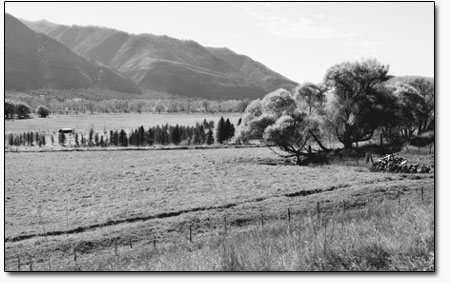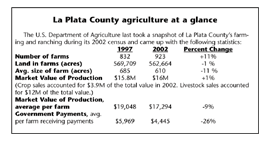|
| ||||||
| The working landscape
by Will Sands Ranches are steadily being split into 35-acre ranchettes, townhomes are replacing tractors, and agriculture is continuing to fade away in La Plata County and Durango. However, La Plata County government and a grassroots coalition are not giving up easily. A citizen-based effort is currently under way to bridge the new and the old and help save the local family farm. While it is a given that agriculture was La Plata County’s first vital industry, the role of agriculture today is murkier. Many farms and ranches are shrinking in size, vanishing altogether or gradually falling into the realm of the hobby farmer. However, the numbers also tell a different story. According to the U.S. Department of Agriculture’s last census in 2002, agriculture remains a $16 million per year industry in La Plata County, and nearly 1,000 farms spanning well over 500,000 acres are continuing to be in the business of growing food. “Whether you just got here yesterday or have been in La Plata County for five generations, the reality is that there is value in ,” said Erick Aune, long-range planner for La Plata County’s Community Development Department. That value is also hanging in the balance, however. Increasingly, residential development is pinching farms and ranches. Aune and other county staffers have got repeated on-the-ground looks at this hardship in recent years. “If we look at the county in its entirety and how the landscape is used, the transition to a new economy is being marked by a loss of agriculture,” he said. “We’re seeing it happen with large parcels being divided into 35-acre tracts. Then those pieces are further subdivided into large lots. The question is, what are the actual costs of losing agriculture to LaPlata County over the long-term?” In order to determine these costs and try to conserve the local agricultural heritage, La Plata County launched the Land Use Net Benefit Program this spring. The county contracted with facilitator/consultant Cindy Dvergsten, of Whole New Concepts LLC, to coordinate the effort. The goal is to get agriculture a better seat at the planning table and ensure that the industry remains viable in the future. “The current climate is that people who want to stay in agriculture are feeling pressured by growth, and there are increasing conflicts between residential and agricultural,” Dvergsten said. “Farmers are also feeling economic pressures to sell-out because of the high land values.” Dvergsten has an inside track on the trials facing local ranchers and farmers. She and her husband have owned and operated Arriola Sunshine Farm, north of Cortez, since 1987. Nonetheless, Dvergsten wanted the full perspective and kicked off the Land Use Net Benefit Program by sitting down with fellow farmers and ranchers all over La Plata County. The picture is not a pretty one. “The average income for farmers in the U.S. and La Plata County is about $10,000 a year,” she said. “Plus, the family farmer gets almost no subsidies. In the national picture, only about 9 percent of income comes from farm subsidies, and most of that is going to corporate farms. Essentially, farmers are getting the same kind of net income today that they got in 1930. Meanwhile, the cost of a new home has gone up 19 times in the same period.”
“We’re trying to take more of a comprehensive approach and ask what we can do to help the landowner,” Aune said. “The goal is to have a nonregulatory environment where we can offer tools to maximize the opportunities available to landowners and not just splitting up the farm and getting a short-term gain.” Numerous tools are available, but there is no one-size-fits-all approach, added Dvergsten. Conservation easements, transferring development rights and opportunities for partial, clustered development are among the many options available to farmers and ranchers who want to remain viable. “We’re looking for an improved decision-making process,” Dvergsten said. “We’d like to get everyone on the same page and get developers working closely with landowners. We also want to put together a menu of options for farmers and ranchers and help them understand how they can get those tools to really work for them.” Dvergsten added that the program is in no way a push for “no growth.” Instead it seeks to better balance the rural reality with future changes in the landscape. The goal is not to block development, but to ensure that it fits within the current context. “We’re trying to see the big picture and make better decisions,” she said. “How do we balance the development of the land and see net benefits? How can we reduce the costs of development to the county and increase the benefits of conserving the working landscape.” The creation of a tool box of resources and decision making aids is the next step for the Land Use Net Benefit Program. Dvergsten is also working up a decision-making map for planners, landowners and others to use as an aid. The hope is that these tools will aid and improve the county’s decision making process. “We’re not trying to reinvent the wheel,” she said. “But a lot of what’s on the books right now is about what you can’t do. We want to look more at positives. Those who want to keep the property in production should be able to, and they should be able to benefit from doing that.” The Land Use Net Benefit Program has ambitious long-term goals. Dvergsten explained that the citizen-based effort wants to foster agriculture as an industry and encourage stewardship of the land. In addition, it would strive to bridge the gap between rural and urban and strengthen the La Plata County community. But this burden rests upon the entire community, not just the landowners. “If you want agriculture to be viable in La Plata County, you need real community support,” she said. “I’m talking about buying at the Farmers Market. The community needs to get together and come up with creative solutions.” Making the move toward agricultural self-sufficiency in La Plata County could be such a solution. “There should be no reason why we can’t raise enough beef to feed La Plata County,” Dvergsten concluded. “When you supply yourself with your own food, you’re keeping money in the community. Suddenly, you have unlimited opportunities for agriculture.”
|
In this week's issue...
- May 15, 2025
- End of the trail
Despite tariff pause, Colorado bike company can’t hang on through supply chain chaos
- May 8, 2025
- Shared pain
Dismal trend highlights need to cut usage in Upper Basin, too
- April 24, 2025
- A tale of two bills
Nuclear gets all the hype, but optimizing infrastructure will have bigger impact




